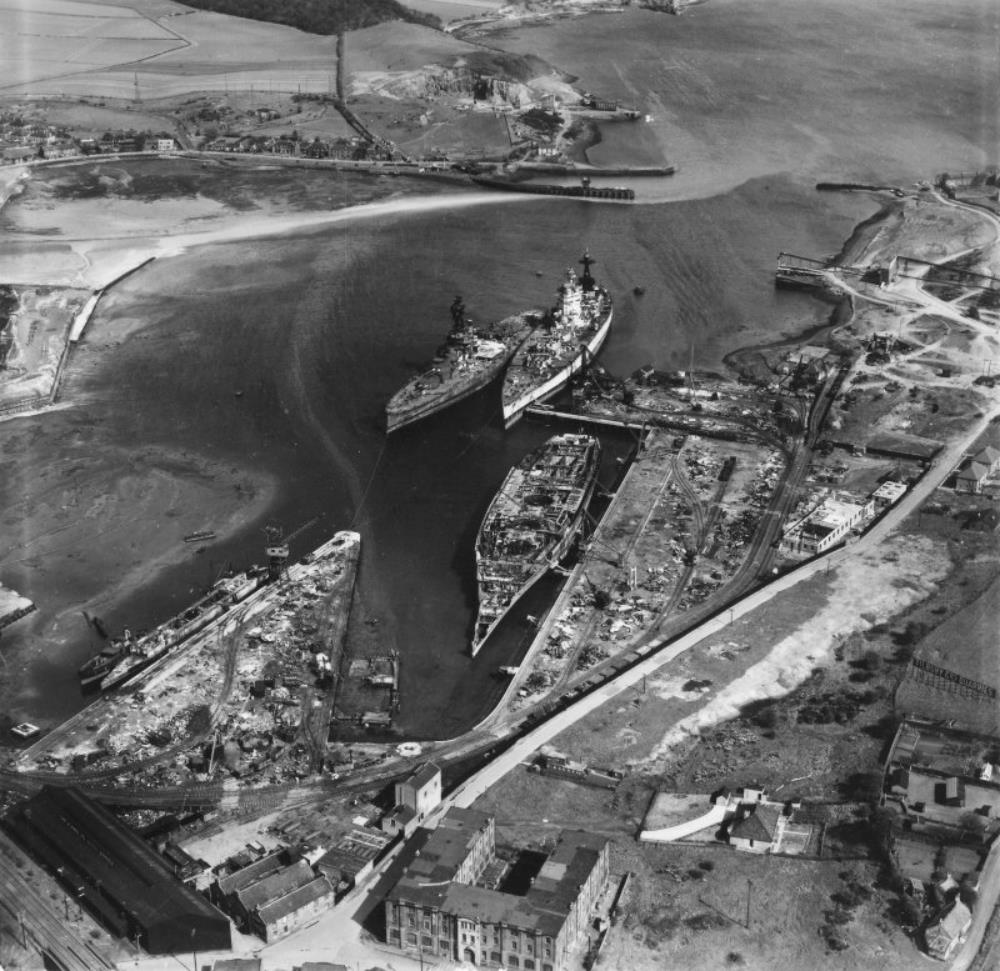Military Sites 2 – Thomas Ward, Shipbreakers, Inverkeithing Bay.
Thos. W. Ward Ltd of Sheffield was a steel, engineering and cement business which began life in 1878 as coal and coke merchants then expanded to recycling metal for Sheffield’s steel industry, engineering and the supply of machinery. In 1894 Ward’s moved into ship breaking at many different locations in the UK.
They began work at Inverkeithing in 1922, on the site of the old brickworks. (Ironically, in 1909 it was proposed to demolish the old brickworks to provide bricks to build cottages for dockyard workers – this scheme was superseded by the Naval Base Mansions.)
This land was initially leased from the Admiralty, who purchased this and the adjoining Cruicks estate in 1920. In 1928, the Admiralty sold the “brickworks land” to Thomas Ward, and Cruicks estate to Tilbury Contracting and Dredging Company, who had operated Cruicks Quarry from 1909.
From 1922 to 1971 a total of 308 ships – 134 Naval and 174 Mercantile – were broken at Inverkeithing by Ward’s.
 The Naval Mansions building is clearly seen in the foreground of this photograph from 1949, along with HMS Nelson, HMS Royal Sovereign and the remains of HMS Rodney.
The Naval Mansions building is clearly seen in the foreground of this photograph from 1949, along with HMS Nelson, HMS Royal Sovereign and the remains of HMS Rodney.
 These wall panels (seen here in a photo-shopped collage) list the 134 Naval and 174 Mercantile ships broken at Inverkeithing between 1922 and 1971 .
These wall panels (seen here in a photo-shopped collage) list the 134 Naval and 174 Mercantile ships broken at Inverkeithing between 1922 and 1971 .
Add Link to Naval ships broken at Inverkeithing
 A wall mural at Wards
A wall mural at Wards
Among the naval ships are five WWI German destroyers which were sunk and then recovered from the Scuttling of the German High Seas Fleet at Scapa Flow. 50 destroyers were involved in the scuttle. 24 were beached or sank in shallow water – some of these were sold to foreign navies, others were used for target practice or simply scrapped at Scapa Flow.
26 sank in deeper water and were later raised and scrapped at Scapa Flow apart from the five that were towed to Inverkeithing in 1924 and 1925.
As well as the destroyers, there were 24 capital ships at Scapa Flow. 4 did not sink and 7 are still lying in deep water Scapa Flow. The remaining 13 ships were raised. One them SMS Bremse was in poor condition when raised in 1929 so was scrapped at Lyness in Scapa Flow.
11 were towed to Rosyth to be scrapped in the graving docks, as Rosyth was not used by the Royal Navy between WWI and WWII.
SMS Moltke -1928
SMS Seydlitz – 1929
SMS Kaiser – 1929
SMS Hindenberg – 1930
SMS Van der Tann – 1931
SMS Prinzregent Luitpold – 1932
SMS Bayern – 1934
SMS König Albert – 1935
SMS Kaiserin – 1936
SMS Freidrich der Grosse – 1937
SMS Grosser Kurfurst – 1938
The last SMS Derrflinger was scrapped at Faslane in 1939 – Rosyth was by then back in service as a Royal Navy dockyard.
Here are more details of Raising the scuttled ships
Back to Military Sites around North Queensferry – Index
top of page
